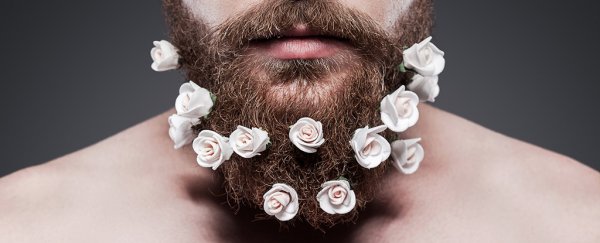The courtship ritual of the peacock is no modest affair – gyrating a heavy fan of shimmering feathers to impress a potential partner. But if his tail feathers aren't as impressive as those of his competitors, the peacock is out of luck.
The most popular evolutionary account of why peacocks have developed these elaborate but cumbersome plumages is that they are an 'honest signal' of the genetic quality of their bearer. Conventional wisdom would have us believe that facial hair in humans functions in a similar way.
As a highly sexually dimorphic trait – something that marks a systematic difference between two sexes of a species – facial hair in humans has been traditionally thought to 'honestly signal' elevated levels of testosterone in those who possess more facial hair than their peers, signaling to potential sexual partners, or perhaps their competition, that they are more masculine or dominant.
However, a new study published in the journal Archives of Sexual Behavior has found no relationship between the amount of facial hair and self-perceived dominance in men and their testosterone levels.
Researchers gathered data from 97 young, physically active men. Many factors can influence testosterone levels in men, so researchers used several controls in the study, including measuring participants' testosterone levels between 7 am and 11 am, as male testosterone levels tend to decrease throughout the day naturally.
Participants were also asked to not smoke, drink alcohol, or exercise 24 hours prior to the study, and they were also asked to refrain from eating or brushing their teeth two hours before the testing (testosterone levels were measured via saliva samples).
First, the participants were asked to answer questions relating to their age, weight, height, and beardedness, which the researchers also measured with digital calipers to a resolution of 0.01 millimeters. The team noted a strong correlation between their objective measurements of beardedness and the participants' self-assessment.
Following all this, their first saliva sample was taken. To increase their testosterone levels, the participants then performed a physical activity (cycling), and after 12 minutes, a second saliva sample was taken. During the 12 minute interval, the men answered questions about their self-perceived dominance.
Dominance in participants was measured in a five-item questionnaire, where they had to assess their agreement with statements like 'I often persuade others to behave as I suggest', and 'It is me who influences others, and not the other way around'.
It is interesting to note that while the study found no evidence that beards are reliable indicators of self-perceived psychological dominance or physiological levels of testosterone, there was also no negative relationship observed.
This would be expected if beards functioned to deceive observers into thinking that bearded individuals had high levels of testosterone, when in fact they possessed them to 'mask' low levels of testosterone. (One interesting example of 'dishonest signaling' in nature is carried out by the male fiddler crab, who sometimes grows a regenerated claw that is larger than its previous claw, but is actually weaker in strength.)
Rather, the authors suggest that male facial hair may just function as an aesthetic self-presentation strategy, entirely based on our cultural norms and not having much to do with an evolutionary signal at all. For example, a farmer with a large, scraggly beard may communicate something entirely different to his peers compared to a metropolitan individual who has spent time curating a stylized look.
In 2020, another study looked into the link between beardedness and psychological dominance and found somewhat contradictory results, where a significant relationship between facial hair and individual dominance was observed. However, in that instance, the researchers didn't use hormone sampling.
While the results from the current study will add further data to the conversation around the potential function of beards in men, the debate will continue to rage on as to whether facial hair is a proxy for male dominance and feelings of masculinity, or whether – at this stage of human evolution – it's just become a matter of fashion.
"We strongly encourage other scholars to replicate our findings with larger samples, so that future meta-analyses may elucidate the associations between beardedness, testosterone levels, and dominance," the researchers conclude.
The study was published in the journal Archives of Sexual Behaviour.
